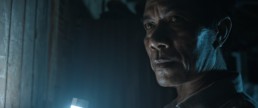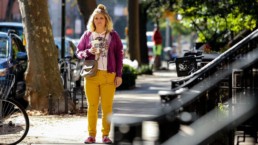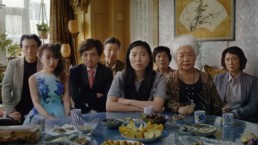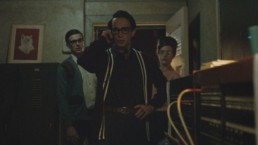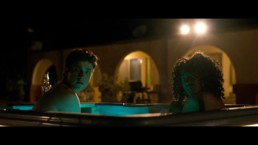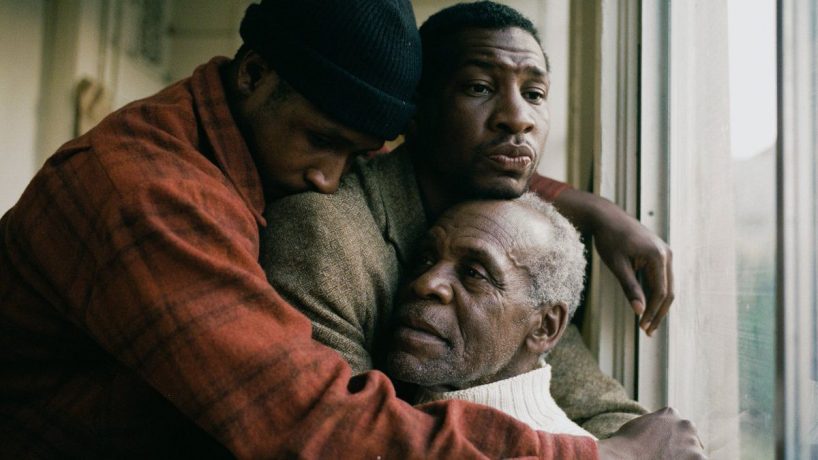A Deep Dive Into the Laos-Set Ghost Story, 'The Long Walk'
Laotian American director Mattie Do was already an up and coming icon in the character-driven horror world, as her acclaimed prior film, Dearest Sister, became Lao’s first submission to the Academy Awards. Do’s latest production, The Long Walk, which we caught at the excellent Brooklyn Horror Fest, cements her as a voice to follow in the genre and in general.
“Times heals all wounds.” That’s the old cliché that Do’s ghost story comes for with a knife, dismembering and examining that notion to remind us that while yes, time can heal wounds, it also can create space for them to rot.
In The Long Walk, we meet several wounded characters: a psychic man, his ghostly companion, and a young woman who seeks the psychic’s insights. Each is captivating in their own right but become more so as their attitudes towards grief clash in some very twisty and surprising scenarios. Unexpected story elements start coming early, and they don’t stop coming. Within the first minute, Do announces the unclassifiable nature of her tale, as the timeless image of a care-worn man walking along a rural road is disturbed by a futuristic jet, bursting into the sky to head towards a hazy megalopolis that rears in the distance.
Do continually injects such beguiling sci-fi elements into her mournful, Laos-set ghost story. The nature of this intermingling is best left unspoiled, but the melding makes for an ambitious and inventive tale whose ideas and images lick at your conscious. Nothing can prepare you for the fearsome, moving, and unexpected roads this story travels.
The basic premise is this: A Laotian man goes through his life with the ability to communicate with ghosts, beginning with his childhood discovery of a fatally injured young woman in the forest. As a boy, he connects with her ghost, and they become a strange sort of companion. Not long after, the boy loses his mother to a wasting illness, a blow which initiates his gradual withdrawal into a more and more isolated and bitter existence. However, his hermetic world is punctured by a young city-dwelling woman who knows his reputation. (He makes no effort to hide his daily chats with ghosts, a habit which marks him a person of interest in the town, though not a particularly approachable one). The young woman hopes his ability can bring her some peace regarding the likely death of her mother, who disappeared from their village while she was away in the city. However, she doesn’t realize how her story triggers the man to reflect on his painful history and downward spiral. Her experience reminds him sharply of how his father went to seek his fortune in the city while abandoning his ill wife and young son.
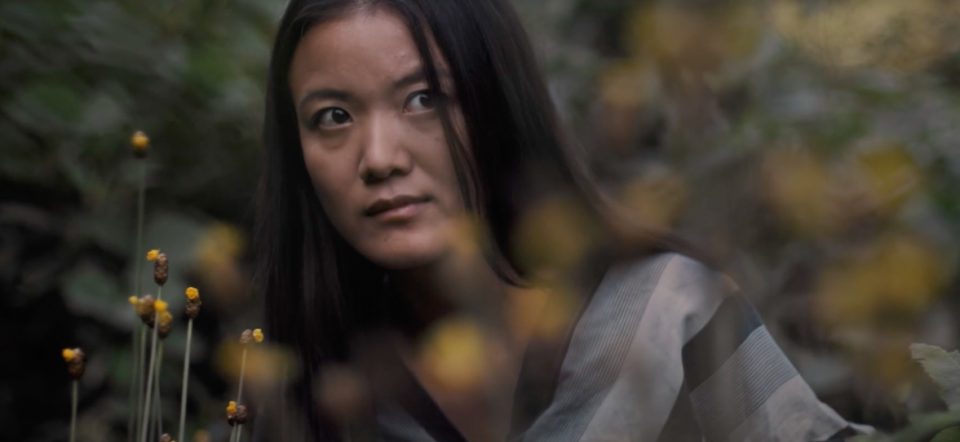
The story is slow-moving in a plot sense, as it covers mere days in the life of the man and woman and relies heavily on flashbacks. However, Do has a great understanding of how core tensions between characters can fill an audience member’s mind with motion even in the “slow” moments of a story. Many scenes are alive with questions like, “How will the man will act on his conflicted impulses of hate and sympathy towards the young woman? Will he help her, or will he twist the knife of her guilt as he sometimes believes she deserves?”
These simmering dynamics make this film an acting and directorial showcase with Yannawoutthi Chanthalungsy giving a captivating lead performance that walks the knife’s edge between tender and unsettling as his character wrestles with his tangled past. Vilouna Phetmany and Noutnapha Soydara meanwhile, also shoulder a massive portion of the narrative as they play the living woman and the murdered girl who complete the central trio. Both have experience as performers and dancers (Phetmany is also a pop musician while Soydara has a background in classical dance and hip hop). This expertise in physically communicating emotion is well-suited to Do’s material, which is sometimes light on dialogue and heavy on thoughtful gazes.
If you’ve read this far, you’ll probably have surmised that The Long Walk isn’t an easy sell for just any audience. It is fairly long and remarkably weird, yet I remain convinced it would be something of a crowd-pleaser for adventurous viewers. Unlike High Life (2019) or Suspiria (2018) – genre arthouse projects that, love them or hate them, objectively divided audiences with their high-key elusive and ambiguous tendencies – The Long Walk is more forthcoming about how its imaginative elements relate to the aching emotions and violent impulses of its characters.
While experimental genre works often leave some hopelessly enamored and others impossibly fuzzy on the events and emotions portrayed, The Long Walk strikes a sweet spot between explanation and enigma. This sweet spot doesn't make it superior or inferior to slipperier fare like Suspiria, but Do's work could prove more accessible than either Denis or Guadagnino's latest if it were afforded anything like the release platform those films had. Cinemacy will cheer on whichever distributor eventually jumps in for the US rollout; The Long Walk is recommended viewing for to those who long for strange, surreal genre fare that provides enough clarity, intrigue, emotional rawness to satisfy while also containing mysteries and moral dilemmas that invite re-watch.
THE LONG WALK (2019)
Starring Yannawoutthi Chanthalungsy, Vilouna Phetmany, Por Silatsa
Directed by Mattie Do
Written by Christopher Larsen
Currently playing the global festival circuit and seeking distribution. 116 minutes.
A conventional trailer is not yet available but a stunning Cinematography montage can be found here, along with an interview with cinematographer Matthew Macar.
'Daniel Isn't Real' is a Radical Horror Film About Radicalization
Daniel Isn't Real is a psychological horror film full of the kind of searing imagery and gooey practical effects that send genre fans hearts soaring with the ravens. I could point to an assault by claymation-esque face tentacles as the moment that won me over, but that's not really true. Because as dazzling as the visuals get, this is a film that captivates not only by landing it's standout set-pieces, but by imbuing every scene and character with just a little more thoughtfulness, empathy, and panache than required. It’s a triumph of accumulated good calls, of moments where the creative team seeks humanity and social relevance in scenes that could have been pure exploitation.
The film's prologue snaps the audience to attention by introducing real and supernatural horror all at once. A young boy, Luke, runs from a fight between his parents in NYC, only to come across the aftermath of a mass shooting. As he absorbs the crime, a taller boy with slicked hair invites him to play. This is the eponymous Daniel, Luke's new, maybe-imaginary friend. At first, Daniel steers Luke away from upsetting realities, beckoning him into a play-world of sword-fighting glory. However, Daniel soon seeks games that draw real blood, suggesting a plan to injure Luke's mother so disturbing that Luke is forced to lock Daniel, and the selfish impulses he represents, away in an over-sized dollhouse.
While the childhood origins of Daniel are pretty par for the horror course, the film’s electrifying central metaphor becomes clearer by the minute as the adult Daniel and Luke bond. For years, Luke keeps Daniel at bay, growing into a sensitive son and college student. He cares for his affectionate but mentally unstable mother, staying home on nights & weekends to keep her company. This takes a toll on his personal life, as he lacks friends and passion for his studies. When Luke's therapist (played magnetically by stage & film actor, Chukwudi Iwuji), advises him to get back in touch with repressed parts of himself, Daniel (now a swaggering Patrick Schwarzenegger) re-emerges to invite the tightly-wound Luke to let loose and act selfishly. Soon after, when Luke's mom (a harrowingly raw Mary Stuart Masterson) engages in self-harm and is hospitalized, Daniel is not so subtly delighted to achieve the pre-eminence in Luke’s life he’s always wanted. Daniel becomes mentor-in-chief, taking Luke on a frantic journey of flirtations, hook-ups, and adventures that allow him to access parts of NYC, and his own personality, he never knew existed.
While Daniel initially operates as a confidante and wingman, convincing Luke he can be and do more with his time, he gradually moves toward pick-up artistry, bullying, misogyny, and violence in his quest to shape Luke in his own image and enact his twisted desires in reality. Sound familiar? It should, because Luke’s arc, while wildly open to interpretation, is stacked with references to the experience of being radicalized into alt-right and incel groups. While Luke does not literally join these groups, his journey of being attracted to an extreme ideology, then repulsed when it shows its true face, is a common arc for lonely young men.
If you’re unfamiliar with these movements, they include many young men who come to Youtube or online forums seeking community, dating advice, or political education. These men often leave with a poisonous view of women and minorities. Reporting on these groups has increased partly because of the violent young men who’ve emerged from the movement. The attackers behind the 2014 Isla Vista shooting, the 2017 Charlottesville Rally car attack and the 2019 Christchurch New Zealand attacks all participated in these online communities. While most young men radicalized online will, of course, not commit mass violence, their views can impact their lives and the lives of those around them profoundly. As the film progresses, Luke fears Daniel might incite him to commit an atrocity like the shooting he witnessed as a child.
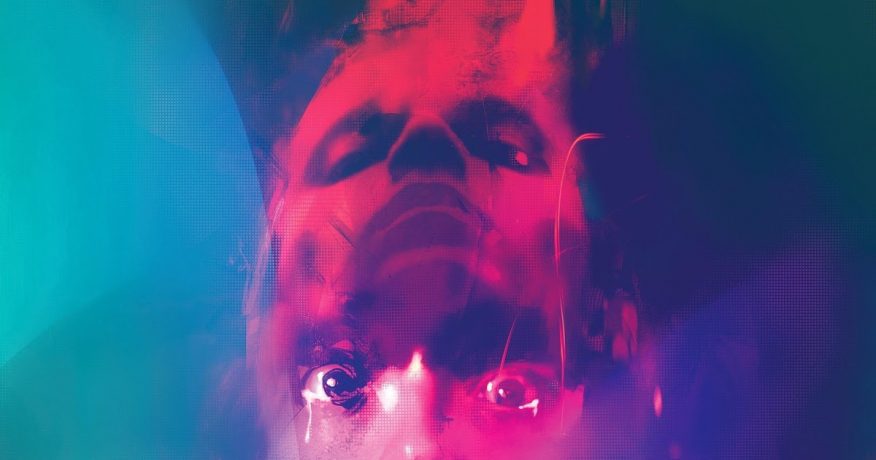
This impression I had, that Daniel Isn’t Real was filtering its depths of psychological horror through the distinctly modern experience of internet radicalization, likely had a lot to do with some of the frank personal essays I’ve come across the topic. In one video essay, Faraday Speaks, an ex-adherent of white nationalist ideology, recounts how he adopted extremist thinking after admiring the self-improvement videos of an alt-right leader and subsequently being recommended more radical content by Youtube’s algorithm. His story could be a plot summary for this Daniel Isn’t Real.
“I was looking for a way to fix myself. I knew there was something wrong with me in terms of my depression. And I knew there was something I could do about it.
I got into self-help, neuroscience. I watched all these different types of videos. And to an extent, all of that helped me.
[white supremacist leader’s name redacted] resonated with me because he had shared the same experiences. He had a traumatic childhood. He had issues with his mother. He had issues with the rest of his family. He had issues with the society around him. He was angry with the society around him that it never stepped in and did anything.
I started listening to him more and more. He was charming and intelligent. He had a different message. I wanted so hard to believe that this person who was like me was able to fix themselves and now talk about how much stronger they were, how much better they were. And that really, really got to me.
As I started to fall for this self-help stuff more and more, in my mind I set him up as an authority figure.
And so, to have that sense of stability and belonging, I did the most paradoxical thing you can. I gave myself up to others. And I became the follower. I was brain-washed.” – Caleb, Faraday Speaks (edited for length)
This is precisely the kind of trusting, parasocial relationship with an angry figure that Luke experiences with his supernatural shadow in the film, and like real young men who become closer to online rage culture than real-life friends, it threatens the quality of Luke’s relationships. This becomes apparent in Luke’s romance with Cassie (Sasha Lane), a volatile but perceptive artist who shares his tendencies towards anger but finds an outlet in art. Luke is adorably admiring of her. It’s one of the rare films where the lead is genuinely enamored by his love interest’s talent, not only her looks, and feels major imposter syndrome in approaching her. Daniel convinces him that he is a solid photographer and should exaggerate his background to hit on her. However, when Luke builds a tender connection with Cassie, Daniel perceives a threat to his control. Just as he sought to remove Luke’s mother from the picture, Daniel also plots to remove Cassie, pushing Luke towards transactional sex with less emotional heft. Even Luke’s hook-up, Sophie (Hannah Marks) is a savvy character. She’s a fellow student whose witnessing of Luke/Daniel’s growing toxicity has real consequences for his standing on campus. These over-achievers really went out and made two imperiled horror love interests consequential and memorable, how often have we seen such a thing? It’s small but gratifying to see every horror character make smart decisions. It makes the danger sting all the more.
While radicalization is far from the only lens you can employ to make sense of Luke’s disorienting descent, it’s certainly a fascinating subtext. Some other interpretations have dubbed Daniel Isn’t Real a horror film “about mental health” because of Luke’s mother’s condition and Luke’s search for a diagnosis. Although mental health certainly has a presence that bears discussing, the story never struck me as primarily “about” mental illness. I’m an enormous fan of films that develop a cinematic language for mental illness. From Eighth Grade’s evocation of a young girl’s social anxiety through a forcefully cheerful soundtrack and yellow color palette to Swiss Army Man’s expressive depiction of loneliness & suicidal ideation by way of Paul Dano hiking a literal and figurative forest of emotional obstacles. However, I don’t believe Daniel Isn’t Real is like those films. It’s a caustic cousin to them, more interested in the extreme ideologies that can prey on, and find expression in, the psychologically or socially vulnerable than in depicting a particular mental illness. The film aims to excavate the hollow shapes young men can contort themselves into when they lack emotional support and feel their hopes and hunger for their lives have been frustrated.
I was fortunate to attend a Q&A where director Adam Egypt Mortimer spoke on the development of the film, offering further insight into the influences of the writers and stars. While the script was based on the 2010 novel, In This Way I Was Saved, by Mortimer’s friend and co-screenwriter Brian DeLeeuw, in the 7-year process of developing the film, the creative team strove to find cultural reference points that grounded their story in current concerns. Mortimer confirmed that reporting about radicalized young men was front of mind. Lead actor Miles Robbins and others became very conscious of the narrative parallels to radicalization, and read up on empathetic critical texts like the bell hooks classic on masculinity, The Will to Change. Their consideration paid off in creating a film that contains rich and relevant vein of social commentary and a lot of scares.
Ultimately, Mortimer’s film proves itself darkly literate in horror filmmaking and sociology. There’s so much passion on display from the nuanced characterizations to the playful homages to classics like The Exorcist and Persona. The film is visually resplendent, with colored lights and practical creature effects galore. I’d expect no less from a film backed by Spectrevision, the horror-centric production company behind Panos Cosmatos psychedelic vengeance trip, Mandy, and Ana Lily Amirpour's comic-book tinged vampire western, A Girl Walks Home Alone at Night. In fact, Daniel Isn’t Real shares key creative personnel with those features, as Girl cinematographer Lyle Vincent shows off his trademark ability to lens alternate worlds on a budget, and Mandy editor Brett W. Bachman reinforces Luke’s frenzied movements with cuts to groaning subways and haunting cosmic voids. Kaet McAnneny’s (Blue Ruin) production design brings the underground tunnels of Brooklyn and the disarray of Luke’s family brownstone to life with an eye for decadent decay.
So, whether the radicalization metaphor I went off on compels you or not, there’s a lot of craft to recommend this. Adventurous viewers will find a captivating depiction of the ancient struggle to find self-worth without falling into self-obsession and to approach others with a healthy desire for connection rather than a festering need to dominate. The imagery and intellect of this story captured me so wholly that I barely feel the need to mention that I might hate the ending. Nevertheless, let’s call this a rave review. I dig 95% of what this film is doing and hope this enthralling title lands distribution soon.
This review was originally posted on June 11, 2019, during the Overlook Film Festival.
Opening this Friday at Alamo Drafthouse Cinema Downtown Los Angeles.
'Brittany Runs a Marathon' is a Character-Driven Dramedy on Body Image
BRITTANY RUNS A MARATHON (2019)
Starring Jillian Bell, Jennifer Dundas, Patch Darragh
Directed by Paul Downs Colaizzo
Written by Paul Downs Colaizzo
Distributed by Amazon Studios. 103 minutes. Opening 8/23 at ArcLight Hollywood and The Landmark.
Director Paul Downs Colaizzo describes his first feature, Brittany Runs a Marathon, as “the story of everyone who, in their late twenties, thought 'Ehh, I can do better. I want to do better.’” With a description that relatable, it’s easy to see how this humble dramedy took home the Sundance U.S. Dramatic Audience Award. There isn’t one among us who hasn’t passed through a period of dissatisfaction with our lives and habits. And Brittany, the titular character of this NYC comedy, is 27, an age which entails maximal levels of angst for many, as the thousand possible life paths to try at that age can make each step feel questionable.
The film digs into that persistent buzz of dissatisfaction and indecision and the ways in which it wears a person down, even a person as good-humored and clever as Brittany. At first glance, the film may look like a typical party girl grows up comedy, but its surprisingly rich exploration of anxiety and self-worth, combined with Jillian Bell’s note-perfect performance, makes this one of the most character-driven dramedies of the decade.
One element of the film that will surely generate much celebration, as well as some fair critique, is Brittany’s relationship to her body and weight. As the film opens, Brittany is a witty theater box office attendant who parties hard. However, we soon learn that, much as she loves to make others laugh, her comic persona is born from insecurity. As a self-described “fat sidekick” to an Instagram influencer bestie, she fights her discomfort with her physical presence by perfecting her comic presence. For Brittany, comedy is the key to belonging and desirability. But her ability to turn everything into a joke means that, while she’s a fantastically entertaining protagonist, she’s less fantastic at sincere conversations.
Her problems come to a head when a doctor alerts her to the ways her current life, drenched in anxiety and alcohol, is failing her. She has high blood pressure and is risking liver damage. The doctor suggests various changes, including weight loss.
One bothersome element is this scene’s emphasis on BMI and goal weights to gauge Brittany’s health. BMI is a controversial measurement and the doctor’s other diagnoses seem more than sufficient in giving Brittany guidance. Nevertheless, he suggests she lose 55 pounds. Insisting on a precise goal weight seems ill-advised, as it can encourage obsessive thoughts and dissatisfaction unless that specific number is reached, even if the person succeeds in implementing new physical and psychological habits.
However, the film does emphasize that Brittany’s eventual choice of running (after she learns her local NYC gym cost upwards of $120/month while jogging outside is free) is not about only weight loss, but the self-possession and community that comes with joining a group of runners. It’s a film about the grinding, satisfying process of making a change, as the burned-out Brittany gradually transforms her life.
Central to this transformation is Brittany’s quiet reckoning with the garbage treatment she’s allowed from friends, dates, and bosses, believing it to be part of the deal when you carry weight. The quiet way Brittany moves into new relationships and drifts from the old is magnificently handled.
In one of my favorite darkly comic scenes of connection, Brittany has a breakdown and lists what’s wrong in her life to a neighbor, played with uptight warmth by Michaela Watkins, who is a fitness buff and accomplished photographer. Brittany insists this woman can’t imagine the supreme crappiness of her existence. As evidence, Brittany offers a story of drunkenly using a rat as a pillow. Irritated at Brittany’s belief that her life is flawless the neighbor responds, “It’s New York City. Of course I’ve slept on a rat.” And thus, an unexpected friendship is born.
With her new buds, also including a lazy, lost NYU grad played by Utkarsh Ambudkar and a young gay father played by Micah Stock, Brittany confronts the self-sabotage and acceptance of abuse that characterized her twenties. The film walks a thorny path in examining Brittany’s relationship to her body and weight loss, but it’s wonderful to have a character as complex and snarky as Brittany to explore these topics alongside. I can’t wait for the world to meet her too.
This review originally ran on February 12, 2019, during the Sundance Film Festival
https://www.youtube.com/watch?v=Ks_HSj1UqKI
'The Farewell' is a Clever and Compassionate Modern Classic
Every January at the Sundance Film Festival, critics, audiences, and distributors gather in secular pilgrimage to usher in a new year in film history. All are hoping to lay eyes on new classics and cult hits as they make their world premieres. At 2019’s festival, these puffy-jacketed crowds were graced with a directorial voice so smart and steady that most everyone in attendance shared in the rush of declaring, “Oh, we’ve just found a LOT of people’s new favorite movie.” And it’s not just festival hype. ‘The Farewell’ is poised to take its place alongside the greatest family dramas, and comedies, in recent history. Here’s what you need to know.
One of the first big laughs of The Farewell comes from a simple flash of onscreen text reading: “Based on an Actual Lie”. It’s a cheeky twist on the self-seriousness way many films announce their basis in reality. The “actual lie” the film is based on was fed to writer-director Lulu Wang’s grandmother after she received a stage four cancer diagnosis. Wang’s family kept the diagnosis secret so that their funny and formidable grandma (affectionately called “Nai-Nai”, the Mandarin term for paternal grandmother) could live her final months unburdened by knowledge of her own illness. The only family member who wasn’t on board for this deception was Lulu Wang, the twenty-something granddaughter, raised in America since elementary school. In this semi-autobiographical adaptation, Wang’s cinematic counterpart is Billi, a struggling writer played with astonishing vulnerability and verve by Crazy Rich Asians breakout star and musician Awkwafina.
Billi reluctantly agrees to keep quiet. However, this means she, and other far-flung family members, now need an excuse to gather around Nai-Nai in China without arousing suspicions. So they pester Billi’s cousin to push his marriage timeline into hyper-drive, staging a slap-dash wedding ceremony with his girlfriend of three months as a pretext for rounding up all the relatives.
Billi’s family is doubtful that she can tamp down her emotive personality enough to keep the secret, and the film draws much comedy out of Nai Nai’s grandmotherly fretting that Billi looks sick and is making odd, intense faces as they plan the wedding. Nevertheless, Billi strives to comprehend and respect the family approach to Nai Nai’s illness.
Now, I’ve noticed when describing this plot to others that, for some, there’s a built-skepticism that comes with hearing about another drama dealing with cancer, familial conflict, and secrecy. I too, wasn’t sure this would be a favorite for me, as these stories can be trite and over-eager to give easy catharsis to everyone by the end of their two-hour runtimes.
But you’d look pretty silly dismissing this film, because Lulu Wang’s richly detailed characterizations, masterful movements between tones, and unique cross-cultural material sweeps these concerns away like so much dust, leaving us with a fresh and open-hearted take on age-old problems of loss and bonding.
Her directorial control of mood and character growth are astounding. She tasks herself with balancing an ensemble cast of aunts, uncles, and cousins and succeeds with a grace rarely equaled since classic 90’s dramedies like Eat Drink, Man Woman, while mining even richer veins of emotion. And many of the most aching emotions belong to the conflicted Billi. So how is Awkwafina in her first dramatic role?
Best known for comic relief in Crazy Rich Asians and comic rapping online, the world was wondering what a more subdued performance from Awkwafina might look like.
Her Billi is an incredible creation and one of the most fully-realized young characters of the decade. Combining the best of Awkwafina’s slouchy, easy-going comic persona with a deeply satisfying emotional arc that made me cry six separate times, both star and director deserve immense credit for bringing Billi to screen. I don’t want to spoil the finer points of Billi’s journey, just know that it’s a lovely exploration of the disorienting effects of distance and time, particularly for a child of immigrants, even in an era when geographical realities can be somewhat, though never entirely, overcome by a phone call.
A list of things that Wang and Awkwafina convinced me to cry at through the power of cinema include: birds, arm exercises, drunk wedding speeches, more birds, and, above all, architecture.
So when can you too experience this cascade of tears that will soothe your spirit and moisturize your skin?
The Farewell does not have an announced release date yet, but it was picked up by the much-celebrated distribution and production company A24, who is known for visually-splendid critical darlings of all genres such as Moonlight, Lady Bird, Eighth Grade, Room, The Witch, Swiss Army Man, and Hereditary.
This is pure speculation, but a Fall 2019 release may be likely if they intend to mount Oscar campaigns for Awkwafina and/or Lulu Wang. Which they most definitely should. Though a summer release could be fitting as well for this family-oriented gem.
The only sure thing is, once this film arrives in the larger world it will be a good long time before any of us are willing to say farewell to the conversations (and careers!) that will be launched by this clever, compassionate modern classic.
This review was originally published on February 11, 2019, during the Sundance Film Festival.
THE FAREWELL (2019)
Starring Awkwafina, Tzi Ma, Diana Lin
Directed by Lulu Wang
Written by Lulu Wang
Distributed by A24. 98 minutes. Opening 7/12 at ArcLight Hollywood and The Landmark.
'The Vast of Night' is Full of Wonder, Terror, and UFOs
The UFO genre has always had a divided soul, split evenly between bleak body horror and wholesome tributes to connection. With his invigorating period piece, The Vast of Night, first-time feature director Andrew Patterson parachutes into this divide and sets up camp by offering story beats that invoke both the light and dark potential of the genre. The film’s brilliant title sets the mood just right. Depending on the reading and intonation, The Vast of Night, could sound hopeful, full of starlight and promise, or intimidating, tinged with unknowable threat.
While I won’t tell you if The Vast of Night is an E.T or an Alien, or confirm if it has creatures at all, I can tell you it’s a film obsessed with wonder, terror, and the fine line between the two. It’s also better at evoking these sensations than 95% of its modern, big-budget counterparts. Set in 1950’s New Mexico, this Twilight Zone inflected story recounts the events of one dizzying evening, in which a young switchboard operator, Fay (Sierra McCormick), hears a radio signal of unknown origin. She ropes in local radio host, Everett (Jake Horowitz), to investigate and they soon find themselves fielding calls from impassioned strangers who claim to know something about the classified history of these signals, and the lights in the sky that accompany them.
The most winning element of The Vast of Night is the way it infuses you with wonder. It captures that breathless, fantastic emotion so well, from the way it shocks us into stilled awe to the way it animates our curiosity. It’s no wonder (haha! I’m so sorry) that the film won the top Jury Prize at the Overlook Film Festival while coming in second for the audience award. I’d challenge anyone to sit down to this film’s first act and not feel giddy, especially once they meet Sierra McCormick, the heart and soul of the film and the embodiment of wonder. This intrepid teen reads everything and lights up when discussing future-facing reports on science & technology. Her eagerness to learn has already attracted the mentorship of radioman Everett before the film begins, establishing a dynamic duo of truth-seekers who could easily headline the Men in Black franchise.
Much credit for this infectious energy also goes to the camerawork. The first act is stacked with ambitious long takes that establish the small town and roving characters with verve. Adam Dietrich’s resurrection of a 1950’s town on a shoestring budget for these shots is glorious, by the by, and apparently involved mini-quests like the production team covering a road with gravel to hide anachronistic parking spots. The film’s most complex take runs from Fay’s office to the high school where the town is gathered to watch a big game (if they could only fix the mysterious electric issues), and beyond. In the post-film Q&A, the team detailed their avoidance of drone footage and other tech trends that could become a crutch. To accomplish this take, they turned to every grounded tool they knew of (which was many, as Patterson had worked in commercial and corporate video for over a decade and founded his own production company). They also recruited every resource in the small Texan towns of Whitney and Hillsboro, including tractors and an 18-year-old go-kart driver. These roving takes never feel like showiness for its own sake. Rather they feel perfectly judged as an energetic infusion into a film that also values and loves stillness.
As you may have surmised from this description, and from the film’s stylized poster of a radio tower, radio is a major influence on this narrative. And it’s radio that creates the film’s treasured pauses, where 10-minute monologues breathe in near absolute stillness. Several times, the screen goes black to allow complete engagement with sound and imagination. It’s a confident and assured maneuver. It’s also aggressively out of line with most trends in genre filmmaking. Today, most action and sci-fi blockbusters hold shots for an average of 3 seconds, constantly refreshing the visual field. While this speedy average shot length isn’t inherently good or bad, it can sometimes be coupled with a dogmatic belief that nothing should be left off-screen, leaving little opportunity for the audience to activate the picture-making parts of our minds that novels and podcasts thrive on.
The Vast of Night puts a lot on its performers in asking them to hold such prolonged attention, but the troupe carries it off magnificently. Some of the tensest scenes feel like a great radio drama, in which a character reveals their long-withheld life story for an open-minded interviewer. Gail Cronauer and Bruce Davis, in particular, own the movie for 10 minutes each as they share their personal history with the mythos of the area. I can’t say more about their performances without spoiling the turns of the plot, but these enveloping monologues do a marvelous job at complicating Fay’s idealism and Everett’s confident problem-solving.
Both Fay and Everett exhibit a voracious hunger for the future, for technology, for a wider world. Early on, they discuss Fay’s belief, based on magazine reports, that underground trains will whisk people across the world at speed and pocket TV screens will connect the globe. I suspect that I, and many people, will be caught up in good-humored nostalgia at Fay’s version of the 1950s, and at the idea that there was a time when people did feel such unbridled optimism for the future. It’s a far cry from the defining anxieties of the present, especially climate catastrophe. Yet, as the film goes on, the focus expands to the fundamental fault lines of that era and our own, including the single mothers, native people, and African American men violently pushed outside of the supposedly every more connected American tapestry.
The Vast of Night is a film of complex moods and messages. It’s enamored with the restorative joy of Fay’s hope for the future, but also full of reminders that the connected world she longs for isn’t guaranteed to be just. That connection, whether made through radio waves or small-town sports, is just as capable of fostering division as progress. But, as the film insistently repeats through its sound design and style, no matter what era, face to face and voice to voice storytelling will always offer some of our best hopes for sifting out the truth. With smarts and style, The Vast of Night makes itself necessary viewing, and listening, for fans of Spielberg, Welcome to Night Vale, or just formally bold independent debuts.
89 minutes. Currently seeking distribution.
'Plus One' review: Surviving Wedding Szn While Single
PLUS ONE (2019)
Starring Maya Erskine, Jack Quaid, Ed Begley Jr.
Directed by Jeff Chan, Andrew Rhymer
Written by Jeff Chan, Andrew Rhymer
Distributed by RLJE Films. 99 minutes. Opening this Friday at Laemmle Monica Film Center and Playhouse 7.
A lot of people don’t like rom-coms. Maybe you are one of those people. I am one of those people, though I’m not exactly a proud member of this taste culture. I’m not a middle school kid shouting “Eww, no way!” at a sleepover when the mere suggestion of Pretty Woman or Notting Hill comes up in the DVD pile, then hurling that sickening DVD behind the sofa to live it’s days in ignominy until the tweens submit to my proposal of Emperor’s New Groove. Okay, I was that kid. But I’ve mellowed!
And these days, I, like any enlightened and curious film essayist, pride myself on open-hearted viewings of all genres. So when a rom-com boasts a fascinating cast (What If), novel adaptation (To All the Boys I’ve Loved Before), or debut director (Plus One) I’m there. After all, the easy dismissal of rom-coms reeks of presumptuous sexism. The notion that romantic relationships & foibles are a less worthy generic foundation than like, bank heists, is deeply silly. And yet, there remains a problem. I still don’t like many rom-coms. Even the beloved ones.
And while the continued indifference that I and many of my peers experience towards the genre could fill its own essays – What is the cause? Internalized sexism? The stifling heteronormativity of the classics? Hatred for the cool, made-up seeming careers of romantic leads? Did we all experience a traumatic allergy to the Italian countryside? Penis envy? (always throw this into any psychological discussions to hedge your bets) – this distaste will sadly not be resolved in this article. All this is a mere prelude to highlight how pleasant it is to say that that I found Jeff Chan and Andrew Rhymer’s Tribeca rom-com debut, Plus One, to be a likable and well-constructed journey. They must be do something right (or very wrong?) to appeal to the likes of me!
The first thing Plus One gets very right is its basic character drama. Ben (Jack Quaid) & Alice (Maya Erskine) are 30-ish, single college friends besieged with wedding invites. To stave off the loneliness they plot to be one another’s “plus ones” at every wedding. This is charming enough as a premise, but the smart scripting choice Chan & Rhymer make in the first 15 minutes to bolster the material is this – they clarify that while Ben & Alice are in the same singles boat, they came to be there for profoundly opposite reasons.
Ben is driven by indecision and the feeling that people are too quick to commit. He’s still crushing on old sweethearts, totally oblivious to the rate at which the flames of his fantasies are getting engaged. Alice, meanwhile, is fresh off a committed relationship and feeling righteously sour. She was decisive and loving, yet got cheated on by her ex anyway. These differing attitudes are on display at the first wedding the duo attends, where Ben explores the dating pool and Alice sulks drunkenly. In one playful three-minute take, the camera swoops around the reception as Ben’s game is interrupted by Alice drifting in and out of frame like a boozy bumper car, sometimes high-fiving herself, sometimes complementing the arms of children. If that sentence didn’t clue you in, Maya Erskine is an off-kilter delight throughout.
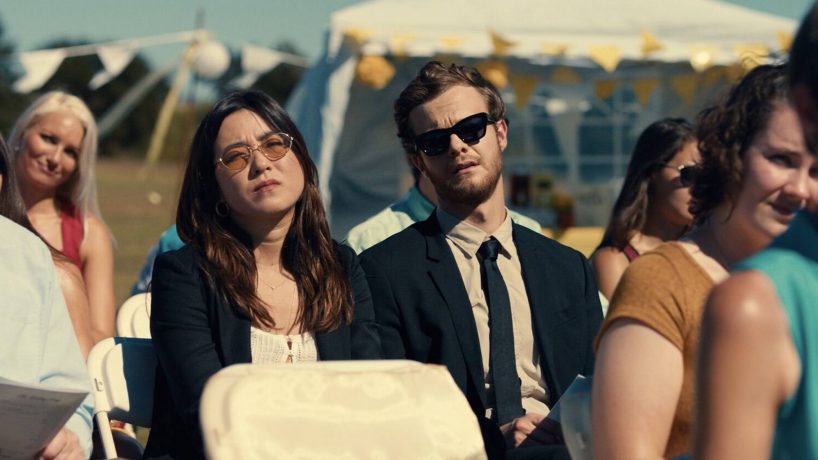
The pair’s clashing moods continue to be dramatized with skillful narrative economy in the first act, as we see that Alice’s apartment was ready to welcome a partnership that’s now been boxed up, while, in his home life, Ben struggles to accept his father’s third marriage, feeling his dad has always been too eager to start something that has failure built in. So Ben seeks endless dating options while Alice longs for a simple back-scratch buddy but is almost too exhausted to try. When Alice does deign to flirt, her approach is gleefully frank, as when she tells a dude, “You look like someone who would do okay on Survivor.” When he asks “Really? Like you think I’d win?” she comes back with, “You’re good looking enough to get far, but not good-looking enough to win.” And it works. I appreciated her high-concept pick-up lines.
But of course, mid-season quality Survivor man was not to be, as Alice and Ben must explore the growing attraction that comes with shared hotel rooms and the emotional intimacy this proximity invites. You probably have some inkling where this was going, but to stay light on spoilers I’ll say that there’s much sweetness to be found in the well-paced middle act as the friends figure out what they’d like to be amidst the marriages.
If I have one major disappointment with the film, it’s that Plus One is not quite the two-hander it initially appears to be, as Ben becomes the clear lead of the third act, and Alice’s story becomes thinner and more calculated to get Ben to the developments he needs to reach. This isn’t terrible by any means, as Ben’s key emotional subplots with his father (Ed Begley Jr. of St. Elsewhere, Pineapple Express) are given space to unfold, but Erskine’s enthused impersonations and knowing eyebrows are sorely missed. It also doesn’t find as much to say about the wacky world of weddings and the industry and norms around them as I’d hoped. In fact, Ben & Alice’s social world at these weddings can feel oddly small. For instance, they never once run into a friend who knew them both in college, though they’ve been friends since then. It feels like a missed opportunity to offer a reflection on their growth.
Yet, on the whole, Plus One unspools thoughtfully, building from the casual weddings to the ones where the characters feel the most anxiety around: that of Ben’s twice-divorced father and Alice’s younger sister. This creates a sharp ticking clock atmosphere that convincingly brings Ben & Alice’s issues of intimacy and family to a head. Co-directors Jeff Chan and Andrew Rhymer display a great facility for staying on theme and keeping momentum throughout, even as they luxuriate in diner and poolside banter scenes.
They overcame some of the reservations of a reviewer who's been known to declare: “Rom- coms? They better be gay or vampires for me to be interested,” and for that I congratulate them. Although this film isn’t my usual, it’s nice. And for lovers of the genre, it should hit the right buttons with an admirable amount of craft. Don’t get me wrong though, if we hang we’re still watching Emperor’s New Groove and that’s final.
'Head Count' Review: Shapeshifters Are Conjured in Joshua Tree
Head Count is a good little film that just wants to spook you, and that is fine by me. While it's by no means a new classic – the ending lands as clangy and hollow as many teen horror third acts – it does find some flair in the journey, bringing an engaging "let's rock out and make a movie in the desert" vibe that's hard to dislike.
Elle Callahan's directorial debut follows 10 college kids who encounter a Creepypasta-era presence in rugged Joshua Tree. This creature that hunts them at their remote rental house is a Hisji, or a shapeshifter, and film's tensest moments come from trying to suss out who among the group is being impersonated in any given scene.
There's maybe nothing horror fans love more than jumping into a feature-length game of "I Spy," and Head Count provides ample opportunity for us to scan the frame with our eyes - desperately seeking ghouls, symbols, and significant numbers. My favorite scenes are the It Follows-esque moments when the camera pans back and forth across a setting, begging you to spot the difference and the telltale moment when the shapeshifter switches between the teenagers.
On the level of pure tension-building engagement, I have few complaints. This is just the kind of movie I would have been happy to throw on in high school as a sleepover was winding down. However, the emotional and thematic elements feel like they feint this way and that, trying to convince you they’ve got a plan to follow-through on amidst the scares before they give up and get engulfed in the tide of blood rolling in.
The main character, Evan (Isaac Jay), has undergone a recent tragedy in the death of his parents. Yet, unlike modern indie horror gems like The Babadook, It Follows, and A Girl Walks Home Alone At Night, Head Count doesn’t quite manage to tie it’s monster to a strong sense of personal journey, despite the potent material. Evan doesn't know the other teens well at all. He joined the group spontaneously to avoid a potentially heavy vacation spent with his brother, who clearly wants to connect after their shared loss. So, like the shapeshifter, Evan’s an unexpected addition to the party.
At times, it seems like Evan’s connection to the shapeshifter will be emotionally meaningful. Evan is probably struggling with his own identity, as a young person who’s faced something darker than many of his peers. He just wants to hot tub and chill with his new photographer crush, Zoe (Ashleigh Morghan), but there’s a darkness he can’t shake. So, of course, he’s the first one to summon and perceive the monster. Isaac Jay plays Evan’s mounting paranoia effectively, showing how it embarrasses and overwhelms him. It’s too bad his arc winds up feeling half-baked by the end, as the monster’s power over him and the others just doesn’t feel very relevant to what we know of their characters.
On the whole, Elle Callahan and company show off a lively commitment to giving the audience the goods when it comes to foreboding imagery, rugged settings, and spooky set decoration. And the sound design, my god. The slithering, insect-like humming that accompanies the creature is pitch-perfect. It’s the kind of sense of play and interest in wringing each and every department out for what it’s worth that you hope to see in a directorial debut. So while I can’t say it’s a new favorite, it was 90 minutes well-spent in seeing the launch of an energizing new talent in indie horror filmmaking. Recommended for those who love researching ghosts and true crime at 2 am. Maybe put this into rotation on your next witching hour internet dive.
Distributed by Samuel Goldwyn Films. 90 minutes. Opening at Arena Cinelounge Sunset this Friday. Now streaming on Youtube Movies and Google Play.
'The Last Black Man in San Francisco' is a Soaring Symphony of Nostalgia
Jimmie Fails (Jimmie Fails) likes to show up unannounced at his childhood home. Usually, he has a can of paint in tow, but this could easily be changed out for gardening equipment or cleaning supplies. Whatever he carries, it’s all in service of realizing the image in his head. In his mind’s eye, there exists a glowing picture of the craftsmanship and colors of this house, which, legend has it, his grandfather designed and built as one of the first black men to prosper in San Francisco. And Jimmie won’t let that history be chipped or faded. So even though his family sold the house decades ago, he keeps coming back to faithfully recreate it as it was, new owners wishes be damned.
The white couple that currently owns the swanky Victorian house would describe Jimmie’s visits as incessant. But Jimmie considers them a passion, a service, and a way to stay close to the house he hopes to someday buy back. You see Jimmy was happy there, for a time, and The Last Black Man in San Francisco suggests that the financial dissolution that led to selling the house was a precursor to a more general dissolution, as Jimmie’s family dispersed and their bonds weakened. So, Jimmie skateboards over with his friend Montgomery (Jonathan Majors) anytime he can- often getting found out by the white couple as he weeds their garden or spruces up their trim. It’s a brisk, even funny introduction to a story whose interests naturally encompass gentrification, environmental racism, the physical and psychological constrictions that come with being a black man, and the crisis of values and, ultimately identity, that San Francisco is currently embroiled in.
This balance between character-driven drama and grand mediations makes The Last Black Man in San Francisco an absolute dream of a film. And I mean that in both senses of the word. It’s a dream in the sense that it seems like the platonic ideal of an independent film. It’s passionate, personal, and perceptive. Director Joe Talbot and star and co-writer Jimmie Fails are lifelong best friends actually adapting the true story of Jimmie’s lost family home. Fails plays himself.
And while autobiographical content doesn’t always a great film make, Jimmie’s odyssey, his quest to get home, feels so mythic and resonant when summarized that it’s hard to imagine the film that steams from that not being worthwhile. And of course, the filmmaker’s aren’t married to autobiographical reality. They use their lives and observations as a leaping off point for their narrative creation.
Which brings me to the second way this film is like a dream. Last Black Man in San Francisco has a loose, exploratory structure. The central story of Jimmie and the house creates clear, conventional goals and momentum, but the film embraces anecdotal detours into other San Francisco residents from nudists and trolley pub bros, to tech workers and street performers. Also prominently featured are the group of young black men who frequent Jimmie and Montgomery’s block, their fights and friendships often serving as inspiration for Jimmie’s best friend Montgomery, an aspiring playwright and director played with warm intensity by Jonathan Majors.
The interstitial scenes where Jimmy and Montgomery skateboard across town together (on one board) are so achingly beautiful and enveloping that you find yourself leaning forward as though catching your balance with them. Some might say these poetic moments, which give themselves over entirely to the magnificent soundtrack and landscapes, begin to overtake the film’s cohesion. While I agree that dreamy detours and unexpected plot points are common in this film, I felt carried along by the vision and eager to untangle each choice.
At Sundance, many echoed the sentiment that The Last Black Man in San Francisco is hard to fully appreciate on first viewing because it combines so many ideas and genres. It’s a buddy comedy, character study, tragedy, social commentary, and tone poem whose visuals are so splendid and real-world relevancy so immediate that it demands the deeper engagement that comes with re-watching, discussion, and contemplation. The tapestry of city life and black masculinity weaved onscreen here is certainly dense, but that dense and branching narrative only makes me more excited to watch the film over and over again. And more importantly, for the world to watch along. Because like the film itself, the discussion of it should be a stirring symphony of voices.
The Last Black Man in San Francisco had its world premiere at the 2019 Sundance Film Festival where it won the U.S Dramatic Directing Award and a Special Jury Award for Creator Collaboration.
THE LAST BLACK MAN IN SAN FRANCISCO (2019)
Starring Jimmie Fails, Jonathan Majors, Danny Glover
Directed by Joe Talbot
Story by Joe Talbot, Jimmie Fails
Distributed by A24. 120 minutes. Now playing at ArcLight Hollywood and The Landmark.

